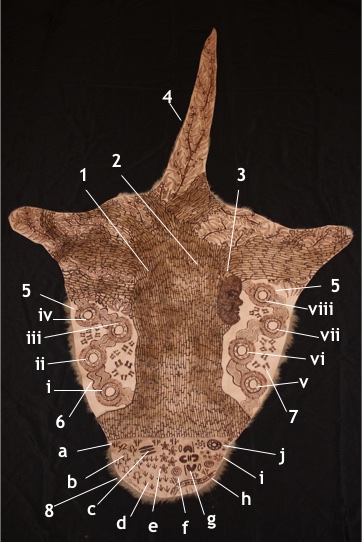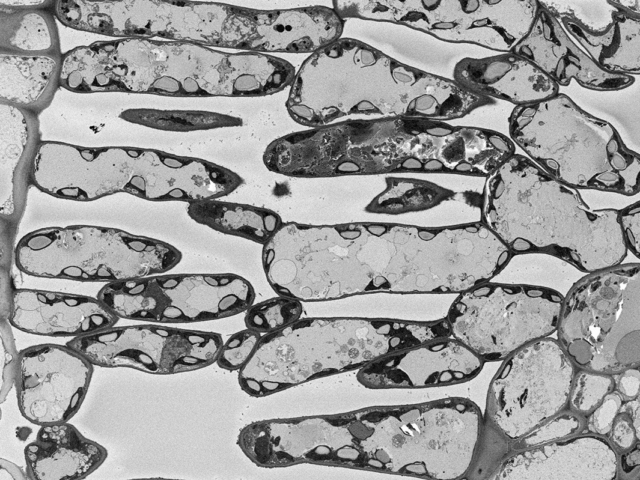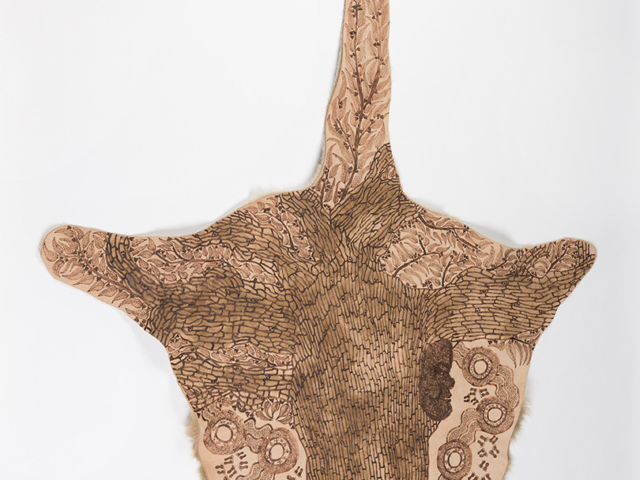|
These are the cells that capture the light and use this energy to produce the food for the trees allowing them to grow and survive in often harsh environments. There are hundreds of Eucalypt species across Australia from ghost gums and river red gums to snow gums and ironbarks. They are important markers in the environment, providing habitat, food, medicines and resources.
The longest cells are 42 micrometres long (1 micrometre is one thousandth of a millimetre).
Image: Minh Huynh, Elinor Goodman and Margaret Barbour |
The Iron Bark tree is a significant tree in my Wiradjuri and Gamilaroi Nations. It is well known across western and north-western NSW. It has dark grey-black furrowed bark – which never sheds, but rather accumulates on the tree over time creating the furrows in the bark. The tree represents strength and continuity as it survives harsh environs and requires burning for the germination of seeds.
The tree is also used for many purposes, such as: the sap/resin which collects in the bark in clusters can be used to dye items and water proof hides, etc. The sap/resin when processed in a different way can also be used as an ointment.
The wisdom face depicted on the tree is to represent the burls found on these trees and which, when taken off and carved out, form beautiful bowls; the face represents the hidden wisdom in tree which we don’t often look at or for and what we can learn from the tree, and the multiple ways these trees can help us.
Artist: Lynette Riley
Iron Bark Tree Cloak – Explanation of Designs.

Note: The sap/resin from an Iron Bark Tree has been processed and used to dye the trunk and branches of the tree on the cloak. This sap/resin was collected and processed by Diane Riley-McNaboe (the artist’s sister).
See image above for number alignment:
1. Iron Bark Tree trunk and branches – patterns on the tree represent the deep furrows found on the tree trunk and branches.
2. Within the bark are small clusters of dots – these represent the clusters of sap/resin found in the Iron Tree bark.
3. The wisdom face on the tree is to represent the burl’s found on these trees and which when taken off and carved out form beautiful bowls; the face represents the hidden wisdom in tree which we don’t often look at or for and what we can learn from the tree, and the multiple ways these trees can help us.
4. Tree leaves and flower buds – surround the tree and extend the length of the Kangaroo hide’s tail.
5. The four – 3 layered – concentric circles on either side of the trees represent our two different moiety groups. The symbols in the outer circle – left side – represent the land; and the symbols in the outer circle – right side – represent water. Both essential for us and our environment.
The second outer circle has differing symbols to represent different Clan groups:
i. Goanna
ii. Fish
iii. Grasses used for weaving
iv. Magpie
v. Kangaroo
vi. Eucalyptus Trees
vii. Emu
viii. Snake
All these Clan groups have a common connection – represented by the blank inner circle – which is the Iron Bark Tree – which connects them all across their Countries.
6. The concentric circles are joined by three wavy lines – representing travelling tracks – these have dots within the length of these lines to represent the Kinship connections between these Clan groups.
7. Footprints around the Clan groups represent the gathering of Aboriginal people in small and large groups to discuss cultural knowledge and teachings.
8. The area below the tree represents sandstone and the engravings found in these stones, where ever Aboriginal people have lived, across Australia. The symbols used (left to right) are:
a. Eucalyptus trees
b. Kangaroos eating and gathering in a mob
c. Three lines drawn together – are directional pointers for journeys across country
d. Emus
e. Bush food
f. Three concentric circles – a camp and gathering of people
g. Men (top and bottom) and women (centre) gathering together
h. Fish in a river
i. Stars
j. Sun |





